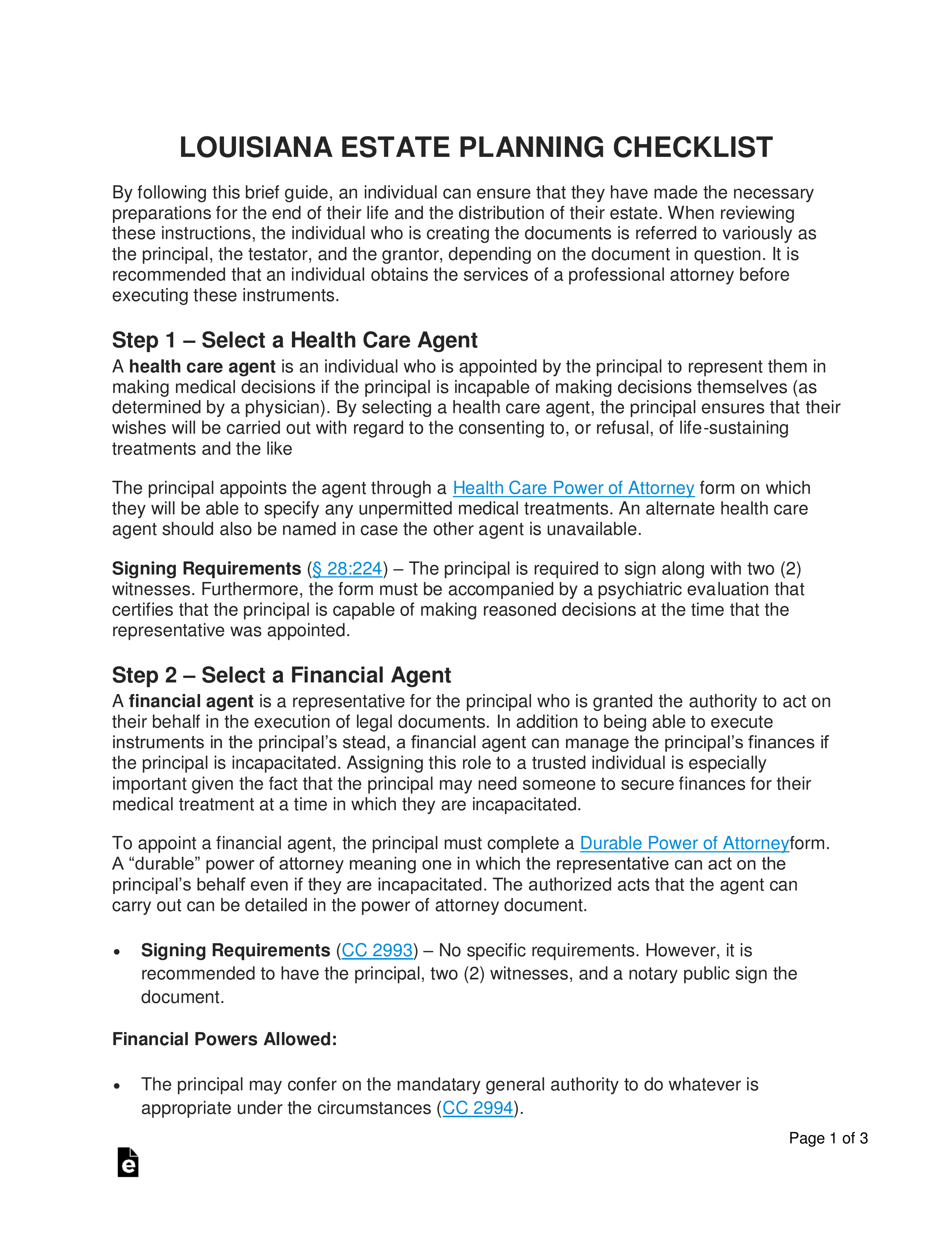Updated March 05, 2024
A Louisiana estate planning checklist is a document that provides a descriptive list of the important forms necessary to set up an individual’s plans for the distribution of their estate. In addition to estate planning, the checklist presents options that an individual may elect to prepare for the loss of decisional capacity. The Last Will and Testament and Revocable Living Trust are the most commonly used legal instruments for planning the division of an individual’s property when they die. The Health Care Power of Attorney and Durable Power of Attorney allow an individual to appoint one (1) or more representatives to make decisions on their behalf in the event that they become incapacitated.
How to Create an Estate Plan in Louisiana (6 steps)
- Select a Health Care Agent
- Select a Financial Agent
- Make a List of All Estate Items
- Designate Beneficiaries and Other Roles
- Execute Estate Transfer Documents
- Keep the Documents Safe
By following this brief guide, an individual can ensure that they have made the necessary preparations for the end of their life and the distribution of their estate. When reviewing these instructions, the individual who is creating the documents is referred to variously as the principal, the testator, and the grantor, depending on the document in question. It is recommended that an individual obtains the services of a professional attorney before executing these instruments.
1. Select a Health Care Agent
A health care agent is an individual who is appointed by the principal to represent them in making medical decisions if the principal is incapable of making decisions themselves (as determined by a physician). By selecting a health care agent, the principal ensures that their wishes will be carried out with regard to the consenting to, or refusal, of life-sustaining treatments.
The principal appoints the agent through a Health Care Power of Attorney form on which they will be able to specify any unpermitted medical treatments. An alternate health care agent should also be named in case the other agent is unavailable.
Signing Requirements – The principal is required to sign along with two (2) witnesses. Furthermore, the form must be accompanied by a psychiatric evaluation that certifies that the principal is capable of making reasoned decisions at the time that the representative was appointed.[1]
2. Select a Financial Agent
A financial agent is a representative for the principal who is granted the authority to act on their behalf in the execution of legal documents. In addition to being able to execute instruments in the principal’s stead, a financial agent can manage the principal’s finances if the principal is incapacitated. Assigning this role to a trusted individual is especially important given the fact that the principal may need someone to secure finances for their medical treatment at a time in which they are incapacitated.
To appoint a financial agent, the principal must complete a Durable Power of Attorney form. A “durable” power of attorney meaning one in which the representative can act on the principal’s behalf even if they are incapacitated. The authorized acts that the agent can carry out can be detailed in the power of attorney document.
- Signing Requirements – No specific requirements. However, it is recommended to have the principal, two (2) witnesses, and a notary public sign the document.[2]
Financial Powers Allowed:
- The principal may confer on the mandatary general authority to do whatever is appropriate under the circumstances.[3]
3. Make a List of All Estate Items
4. Designate Beneficiaries and Other Roles
5. Execute Estate Transfer Documents
After deciding how they would like to divide their estate, the principal must choose the method by which they will transfer their estate. There are two (2) legal instruments that are most commonly used for estate planning.
Last Will and Testament – Drafting a Will is usually the simpler option for the testator (principal/creator), however, the document must pass through the probate process before the testator’s estate is distributed. A Last Will and Testament allows the testator to leave instructions on how their estate should be divided amongst their beneficiaries, as well as any other final instructions they would like to have carried out.
- Signing Requirements – Must be signed by the testator, two (2) witnesses, and a notary public.[5]
Revocable Living Trust – Unlike a Will which is effective upon the death of the principal, a Living Trust becomes effective immediately after the grantor signs the document. Following the execution of the trust form, the principal (called the grantor) can transfer the ownership of assets in their estate to the entity. During their lifetime the grantor can still use and benefit from their property and assets. When they die, the grantor’s Trust estate will be distributed without probate.
- Signing Requirements – All individuals who have appointed roles in the trust must sign (trustees, grantor, beneficiaries) in the presence of notary public, who also must subscribe (doesn’t need to be the same notary). The trustees are also permitted to sign their consent on a separate form. If a notary is not present for the principal’s signature, the signature of two (2) witnesses are required.[6][7]
6. Keep the Documents Safe
Louisiana Estate Planning Laws
- Advance Health Care Directive – Title 28 – Mental Health
- Durable Power of Attorney – CC 2985 to CC 3034
- Last Will and Testament – CC 1577 to CC 1582.1
- Living Trust (Revocable) – Louisiana Trust Code – § 9:1721 et seq.


